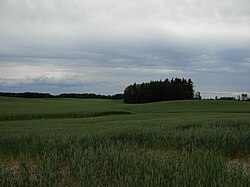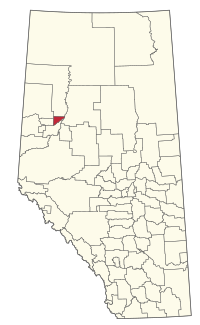Municipal District of Peace No. 135
Municipal District of Peace No. 135 | |
|---|---|
 Grain fields in the Peace Country | |
 Location within Alberta | |
| Country | Canada |
| Province | Alberta |
| Region | Northern Alberta |
| Census division | 19 |
| Established | 1916 |
| Incorporated | 1945 |
| Government | |
| • Reeve | Robert Willing |
| • Governing body | MD of Peace Council |
| • Administrative office | adjacent to Berwyn |
| Area (2021)[2] | |
| • Land | 847.22 km2 (327.11 sq mi) |
| Population (2021)[2] | |
| • Total | 1,581 |
| • Density | 1.9/km2 (5/sq mi) |
| Time zone | UTC−7 (MST) |
| • Summer (DST) | UTC−6 (MDT) |
| Website | mdpeace.com |
The Municipal District of Peace No. 135 is a municipal district (MD) in northwestern Alberta, Canada. Located in Census Division No. 19, its municipal office is located outside but adjacent to the Village of Berwyn.
Geography
[edit]Communities and localities
[edit]|
The following urban municipalities are surrounded by the MD of Peace No. 135.[3]
The following hamlets are located within the MD of Peace No. 135.[3] |
The following localities are located within the MD of Peace No. 135.[4]
|
Demographics
[edit]| Year | Pop. | ±% |
|---|---|---|
| 1916 | 918 | — |
| 1921 | 1,337 | +45.6% |
| 1926 | 1,377 | +3.0% |
| 1931 | 1,990 | +44.5% |
| 1936 | 2,155 | +8.3% |
| 1941 | 2,003 | −7.1% |
| 1946 | 1,791 | −10.6% |
| 1951 | 1,741 | −2.8% |
| 1956 | 1,732 | −0.5% |
| 1961 | 1,917 | +10.7% |
| 1966 | 1,745 | −9.0% |
| 1971 | 1,624 | −6.9% |
| 1976 | 1,583 | −2.5% |
| 1981 | 1,520 | −4.0% |
| 1986 | 1,527 | +0.5% |
| 1991 | 1,481 | −3.0% |
| 1996 | 1,562 | +5.5% |
| 2001 | 1,496 | −4.2% |
| 2006 | 1,487 | −0.6% |
| 2011 | 1,446 | −2.8% |
| 2016 | 1,747 | +20.8% |
| Source: Statistics Canada [5][6][7][8][9][10][11][12][13][14][15] | ||
In the 2021 Census of Population conducted by Statistics Canada, the MD of Peace No. 135 had a population of 1,581 living in 577 of its 654 total private dwellings, a change of -9.8% from its 2016 population of 1,752. With a land area of 847.22 km2 (327.11 sq mi), it had a population density of 1.9/km2 (4.8/sq mi) in 2021.[2]
In the 2016 Census of Population conducted by Statistics Canada, the MD of Peace No. 135 had a population of 1,747 living in 578 of its 639 total private dwellings, a 20.8% change from its 2011 population of 1,446. With a land area of 847.47 km2 (327.21 sq mi), it had a population density of 2.1/km2 (5.3/sq mi) in 2016.[16]
Economy
[edit]Agriculture is a significant part of the area's economy, with the region being dubbed as most northern agricultural industry oasis in the world.[17] The region has unique growing combination of a northern climate, fertile soils, and a watershed system fed by glacial run offs.
Attractions
[edit]See also
[edit]- List of communities in Alberta
- List of francophone communities in Alberta
- List of municipal districts in Alberta
References
[edit]- ^ "Municipal Officials Search". Alberta Municipal Affairs. May 9, 2019. Retrieved October 1, 2021.
- ^ a b c "Population and dwelling counts: Canada, provinces and territories, and census subdivisions (municipalities)". Statistics Canada. February 9, 2022. Retrieved February 9, 2022.
- ^ a b "Specialized and Rural Municipalities and Their Communities" (PDF). Alberta Municipal Affairs. June 3, 2024. Retrieved June 14, 2024.
- ^ "Standard Geographical Classification (SGC) 2006, Economic Regions: 4819071 - Peace No. 135, geographical codes and localities, 2006". Statistics Canada. March 5, 2010. Retrieved August 12, 2012.
- ^ "Table IV: Population of Prairie Provinces by Municipalities, Local Improvement Districts or Unorganized Territorial Units, 1916". Census of Prairie Provinces, 1916. Ottawa: Department of Trade and Commerce. 1918.
- ^ "Table 6: Population by census divisions of Alberta classified by municipalities for census years, 1921 and 1926". Census of Prairie Provinces, 1926. Ottawa: Department of Trade and Commerce. 1929.
- ^ "Table 6: Population by census subdivisions, 1926-1946". Census of the Prairie Provinces, 1946. Vol. I: Population. Ottawa: Dominion Bureau of Statistics. 1949.
- ^ "Table 6: Population by sex, for census subdivisions, 1956 and 1951". Census of Canada, 1956. Vol. I: Population. Ottawa: Dominion Bureau of Statistics. 1958.
- ^ "Table 9: Population by census subdivisions, 1966 by sex, and 1961". 1966 Census of Canada. Western Provinces. Vol. Population: Divisions and Subdivisions. Ottawa: Dominion Bureau of Statistics. 1967.
- ^ "Table 3: Population for census divisions and subdivisions, 1971 and 1976". 1976 Census of Canada. Census Divisions and Subdivisions, Western Provinces and the Territories. Vol. Population: Geographic Distributions. Ottawa: Statistics Canada. 1977.
- ^ "Table 2: Census Subdivisions in Alphabetical Order, Showing Population Rank, Canada, 1981". 1981 Census of Canada. Vol. Census subdivisions in decreasing population order. Ottawa: Statistics Canada. 1982. ISBN 0-660-51563-6.
- ^ "Table 2: Population and Dwelling Counts, for Census Divisions and Census Subdivisions, 1986 and 1991 – 100% Data". 91 Census. Vol. Population and Dwelling Counts – Census Divisions and Census Subdivisions. Ottawa: Statistics Canada. 1992. pp. 100–108. ISBN 0-660-57115-3.
- ^ "Population and Dwelling Counts, for Canada, Provinces and Territories, and Census Divisions, 2001 and 1996 Censuses – 100% Data (Alberta)". Statistics Canada. Retrieved May 28, 2019.
- ^ "Population and dwelling counts, for Canada, provinces and territories, and census subdivisions (municipalities), 2006 and 2001 censuses – 100% data (Alberta)". Statistics Canada. January 6, 2010. Retrieved May 28, 2019.
- ^ "Census Profile, 2016 Census". Statistics Canada. February 8, 2017. Retrieved May 28, 2019.
- ^ "Population and dwelling counts, for Canada, provinces and territories, and census subdivisions (municipalities), 2016 and 2011 censuses – 100% data (Alberta)". Statistics Canada. February 8, 2017. Retrieved February 8, 2017.
- ^ "Defining Quality of Peace Country Agriculture" (PDF). Branding the Peace Country Association. April 2009. Archived from the original (PDF) on October 3, 2011. Retrieved March 23, 2011.


